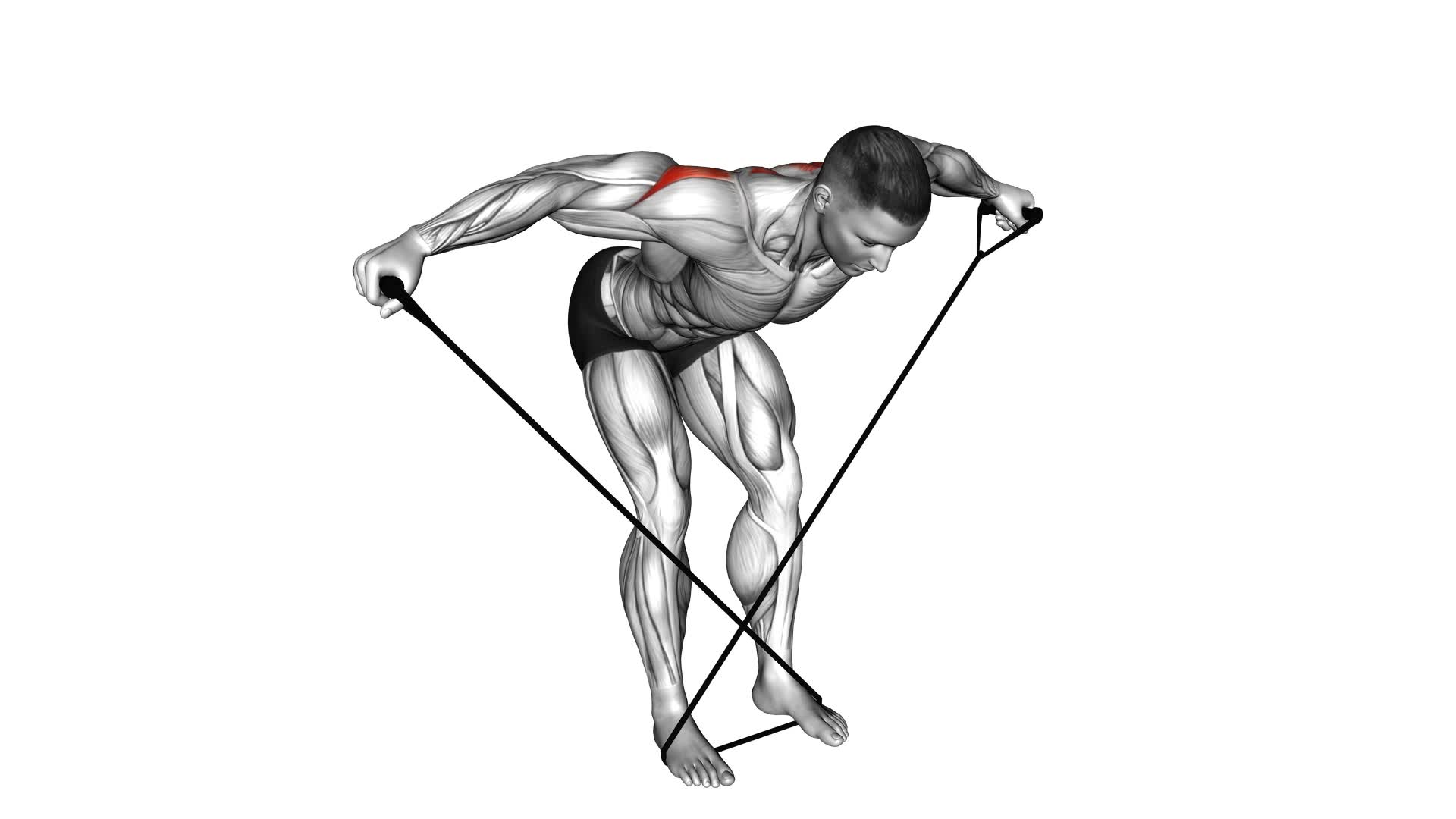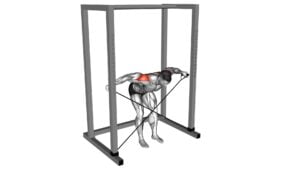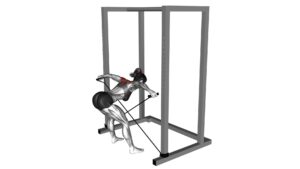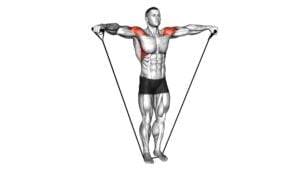Band Bent Over Rear Lateral Raise (Male) (Version 2) – Video Exercise Guide & Tips

Get ready to blast your rear delts with the Band Bent Over Rear Lateral Raise! This exercise targets the muscles in your shoulders, giving you a strong and defined upper body.
Watch This Exercise Video
In this video guide, we'll show you the proper form and technique for maximum results. Whether you're a beginner or advanced fitness enthusiast, we've got modifications and progressions to suit your needs.
Avoid common mistakes and take your workout to the next level with this effective resistance band exercise.
Let's get started!
Key Takeaways
- Band Bent Over Rear Lateral Raise targets rear deltoids, traps, rhomboids, and upper back muscles.
- It enhances shoulder stability and strengthens muscles responsible for posture and scapular retraction.
- This exercise improves shoulder mobility and flexibility.
- Incorporating resistance bands adds variety to training sessions and allows for targeting specific muscles.
Benefits of the Band Bent Over Rear Lateral Raise
You can experience several benefits from incorporating the Band Bent Over Rear Lateral Raise into your workout routine. This exercise primarily targets the rear deltoids, but also engages the traps, rhomboids, and upper back muscles. By regularly performing this movement, you can enhance your shoulder stability and strengthen the muscles responsible for posture and scapular retraction.
One of the key benefits of the Band Bent Over Rear Lateral Raise is its versatility. You can perform this exercise with different variations to target specific muscles or add variety to your routine. For example, using a resistance band allows for adjustable resistance levels, making it suitable for individuals of all fitness levels. Additionally, you can modify the exercise by changing the grip, hand position, or incorporating other equipment like dumbbells or cables.
Another advantage of this exercise is its ability to improve shoulder mobility and flexibility. The controlled movement required for the Band Bent Over Rear Lateral Raise helps to increase range of motion in the shoulder joint, reducing the risk of injuries and enhancing overall shoulder function.
Incorporating the Band Bent Over Rear Lateral Raise into your workout routine can provide numerous benefits, including improved shoulder stability, enhanced posture, increased shoulder mobility, and flexibility. With its various variations, this exercise offers the opportunity to target specific muscles and add variety to your training sessions.
Proper Form and Technique for the Exercise
To perform the Band Bent Over Rear Lateral Raise exercise correctly, start by gripping the resistance band with your palms facing down. Stand with your feet shoulder-width apart and slightly bend your knees. Then, hinge forward at your hips, maintaining a neutral spine and keeping your back flat.
Here's why proper form and technique are crucial in resistance training:
- Prevents injury: Using proper form ensures that the targeted muscles are engaged and the stress is distributed evenly. This reduces the risk of strain or injury to your shoulders, back, or neck.
- Maximizes results: Proper technique allows you to effectively target the rear deltoids, upper back, and traps. By maintaining the correct posture throughout the exercise, you can optimize muscle activation and achieve better results.
- Enhances muscle balance: Maintaining correct form helps in developing balanced strength across your upper body. This is important for overall functional fitness and reducing the risk of muscle imbalances that can lead to poor posture or injuries.
Tips for Maximizing Results With Resistance Bands
To maximize your results with resistance bands, focus on incorporating these tips into your workout routine.
First, when using resistance bands, it's important to ensure that you have proper form and technique. This will help you target the specific muscles you want to work and prevent injury.
Secondly, to improve muscle activation, try incorporating bands into other exercises. For example, you can add resistance bands to your squats or lunges to make them more challenging and engage more muscles. This will help you get the most out of your workouts and see better results.
Additionally, vary your resistance band exercises to target different muscle groups and prevent plateaus.
Finally, make sure to adjust the intensity of your resistance band workouts as you progress. This can be done by using bands with different levels of resistance or increasing the number of repetitions and sets.
By following these tips, you can maximize the effectiveness of your resistance band workouts and achieve your fitness goals.
In the next section, we'll discuss modifications and progressions for different fitness levels, so you can continue to challenge yourself and make progress.
Modifications and Progressions for Different Fitness Levels
To modify and progress your workouts for different fitness levels, consider incorporating variations and advancements that target specific muscle groups. Here are three modifications and progressions that you can try to tailor the Band Bent Over Rear Lateral Raise exercise to your fitness level:
- Modifications for beginners:
- If you're new to this exercise or have limited upper body strength, start by using a lighter resistance band or no band at all.
- Focus on mastering the correct form and technique before gradually increasing the resistance.
- You can also perform the exercise while seated on a bench or stability ball to provide additional support.
- Advanced variations:
- Once you've built strength and mastered the basic form, you can challenge yourself with advanced variations.
- One option is to use a heavier resistance band or multiple bands to increase the intensity of the exercise.
- Another option is to perform the exercise on an unstable surface, such as a BOSU ball or a balance board, to engage more muscles and improve core stability.
By incorporating these modifications and progressions into your workouts, you can gradually increase the difficulty and continue challenging your muscles.
Now, let's move on to the next section and discuss common mistakes to avoid while performing the Band Bent Over Rear Lateral Raise exercise.
Common Mistakes to Avoid While Performing the Exercise
When performing the Band Bent Over Rear Lateral Raise exercise, it's important to avoid these common mistakes to ensure proper form and maximize the benefits of the exercise.
One common mistake is using too much weight or resistance. Remember, the goal is to target the rear deltoids, not to lift as much weight as possible. Using excessive resistance can lead to poor form and increase the risk of injury.
Another mistake to avoid is hunching or rounding the back during the exercise. This can put unnecessary strain on the lower back and detract from the targeted muscles. Instead, maintain a neutral spine and engage the core muscles for stability.
Additionally, avoid swinging the body or using momentum to lift the bands. This cheats the exercise and reduces its effectiveness. Instead, focus on controlled and deliberate movements, lifting the arms to the sides while keeping the elbows slightly bent.
Frequently Asked Questions
How Many Reps and Sets Should I Do for the Band Bent Over Rear Lateral Raise?
To determine the number of reps and sets for the band bent over rear lateral raise, you should consider your fitness goals and experience level.
Generally, it's recommended to perform 3-4 sets of 8-12 reps for muscle hypertrophy and strength gains.
However, you can vary the exercise by changing the resistance band tension, grip width, or tempo.
Remember to start with lighter weights and gradually increase as you progress.
Consult a fitness professional for personalized recommendations.
Can I Use Dumbbells Instead of Resistance Bands for This Exercise?
Yes, you can use dumbbells as an alternative to resistance bands for the band bent over rear lateral raise. Using dumbbells offers similar benefits to the exercise, such as targeting your rear deltoids and upper back muscles.
It also allows for a greater range of motion and increased resistance. Just make sure to maintain proper form and start with a weight that's appropriate for your fitness level.
What Muscles Does the Band Bent Over Rear Lateral Raise Target?
The band bent over rear lateral raise targets the rear deltoids, which are the muscles in the back of your shoulders. This exercise specifically activates and strengthens these muscles, helping to improve your overall shoulder stability and posture.
Using resistance bands for this exercise provides added benefits, such as variable resistance throughout the movement and increased muscle activation. Resistance band exercises are a great way to challenge your muscles and add variety to your workout routine.
Is It Necessary to Warm up Before Performing This Exercise?
Before performing this exercise, it's highly recommended that you warm up.
Warming up helps increase blood flow, flexibility, and prepares your muscles for the workout. It also reduces the risk of injury.
If you're looking for alternatives to the band bent over rear lateral raise, you can try dumbbell lateral raises or cable lateral raises.
These exercises target the same muscles and provide similar benefits.
Remember to always consult with a fitness professional for proper form and technique.
Can I Incorporate the Band Bent Over Rear Lateral Raise Into a Full-Body Workout Routine?
Yes, you can definitely incorporate the band bent over rear lateral raise into your full-body workout routine. This exercise targets your rear deltoids, improving your shoulder strength and posture.
It also engages your upper back, making it a great addition to your overall upper body workout.
To perform it correctly, make sure to maintain a slight bend in your knees, keep your back straight, and lift the bands out to the sides while squeezing your shoulder blades together.
Conclusion
In conclusion, the band bent over rear lateral raise is a highly effective exercise for targeting the rear deltoids and upper back muscles. By maintaining proper form and technique, utilizing resistance bands, and making necessary modifications for different fitness levels, individuals can maximize their results with this exercise.
It's important to avoid common mistakes and focus on engaging the targeted muscles to achieve optimal benefits. Incorporating the band bent over rear lateral raise into a well-rounded fitness routine can help individuals strengthen and tone their upper body.

Author
Years ago, the spark of my life’s passion ignited in my mind the moment I stepped into the local gym for the first time. The inaugural bead of perspiration, the initial endeavor, the very first surge of endorphins, and a sense of pride that washed over me post-workout marked the beginning of my deep-seated interest in strength sports, fitness, and sports nutrition. This very curiosity blossomed rapidly into a profound fascination, propelling me to earn a Master’s degree in Physical Education from the Academy of Physical Education in Krakow, followed by a Sports Manager diploma from the Jagiellonian University. My journey of growth led me to gain more specialized qualifications, such as being a certified personal trainer with a focus on sports dietetics, a lifeguard, and an instructor for wellness and corrective gymnastics. Theoretical knowledge paired seamlessly with practical experience, reinforcing my belief that the transformation of individuals under my guidance was also a reflection of my personal growth. This belief holds true even today. Each day, I strive to push the boundaries and explore new realms. These realms gently elevate me to greater heights. The unique combination of passion for my field and the continuous quest for growth fuels my drive to break new ground.







